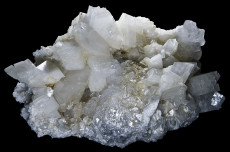NERSC Helps Uncover the Mechanism Behind the ‘Dolomite Problem’
Science Highlight
January 9, 2024
By Elizabeth Ball
Contact: cscomms@lbl.gov

Crystals of dolomite, or calcium magnesium carbonate, shown here growing naturally on a piece of talc. Dolomite has not previously been readily grown under lab conditions. (Credit: By Didier Descouens - Own work, CC BY-SA 4.0)
Science Background
Dolomite, or calcium magnesium carbonate (CaMg(CO3)2), is a major component of carbonate rocks but has historically been an outlier among minerals: while crystals tend to grow in supersaturated solutions at ambient temperatures, dolomite has not been readily produced in the lab – the so-called “dolomite problem.” ’
Science Breakthrough
Using supercomputers at NERSC, researchers at the University of Michigan led by Assistant Professor and past Lawrence Berkeley National Laboratory (Berkeley Lab) Staff Scientist Wenhao Sun have revealed the key mechanism that inhibits dolomite growth and explained how it forms in nature. Using atomistic simulations, Ph.D. student Joonsoo Kim showed that in a supersaturated solution, dolomite initially precipitates a disordered surface, which inhibits further crystal growth – but also that mild undersaturation of the solution dissolved those disordered areas, allowing them to be rebuilt in a more ordered fashion. By cycling a solution between supersaturation and slight undersaturation, they were able to speed dolomite growth by up to seven orders of magnitude. Validation experiments using in situ liquid cell electron microscopy confirmed their theory. Their work was published in Science in November 2023.
Science Breakdown
To study crystal growth at nanometer length scales and geological timescales, the team developed a Kinetic Monte Carlo (KMC) simulation to observe the disordering of the dolomite surface and its re-ordering. This simulation required quantum-mechanically accurate formation energies of random configurations of disordered dolomite surfaces. However, using Density Functional Theory (DFT) to calculate every step of the KMC simulation was deemed prohibitively expensive.
Instead, they used a cluster expansion model to calculate the energies of random disordered dolomite surface structures while maintaining quantum-mechanical accuracy, a process that took two microseconds on a desktop computer rather than 5,000 CPU hours or more on a supercomputer.
To train the cluster expansion algorithm, the researchers used NERSC’s Cori supercomputer to produce a training set comprising approximately 600 DFT-calculated energies of different configurations of disordered dolomite. They then used the trained cluster expansion algorithm to execute the dolomite surface ordering process via KMC simulation, allowing them to computationally validate their key hypothesis: that dolomite growth, in fact, requires dissolution and the elimination of the Ca/Mg disordering that inhibits the growth of the crystals.
Research Lead
Joonsoo Kim, Department of Materials Science and Engineering, University of Michigan
Co-authors
Yuki Kimura, Brian Puchala, Tomoya Yamazaki, Udo Becker, Wenhao Sun
Publication
Joonsoo Kim et al., “Dissolution enables dolomite crystal growth near ambient conditions.” Science 382, 915-920 (2023). DOI:10.1126/science.adi3690
Funding
The U.S. Department of Energy Office of Science, Office of Basic Energy Sciences, partially funded this work.
User Facilities
National Energy Research Scientific Computing Center (NERSC)
About NERSC and Berkeley Lab
The National Energy Research Scientific Computing Center (NERSC) is a U.S. Department of Energy Office of Science User Facility that serves as the primary high performance computing center for scientific research sponsored by the Office of Science. Located at Lawrence Berkeley National Laboratory, NERSC serves almost 10,000 scientists at national laboratories and universities researching a wide range of problems in climate, fusion energy, materials science, physics, chemistry, computational biology, and other disciplines. Berkeley Lab is a DOE national laboratory located in Berkeley, California. It conducts unclassified scientific research and is managed by the University of California for the U.S. Department of Energy. »Learn more about computing sciences at Berkeley Lab.







